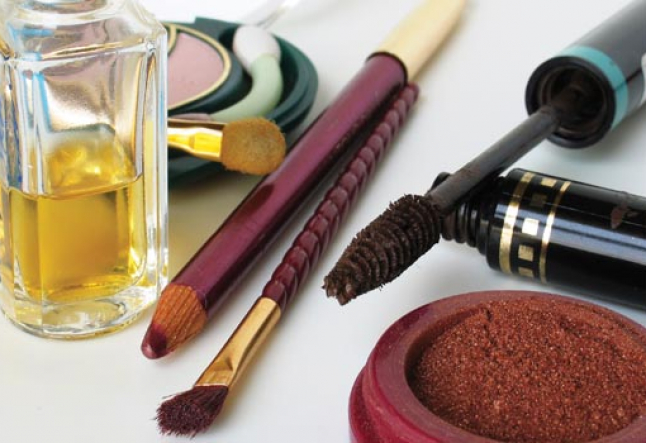what’s in your makeup?

It’s 7 a.m., time to get ready for your workday. First, touch up your nails with ethyl methacrylate and then line your lids with chromium hydroxide green. Brush some titanium dioxide across your cheekbones, pizzazz your pucker with some D&C Red No. 27 (the pearly effect courtesy of bismuth oxychloride) and you’re good to go!
Or are you? While your appearance may be great, behind the scenes there is a chemical war being waged on your body, courtesy of all the health and beauty aids you sprayed, rubbed, brushed and rolled on. Choosing makeup involves more than selecting the right shade and formulations for your skin color and type. You also want cosmetics that won’t have a negative impact on your body.
Also read >>> Portable Sauna – An In Depth Look
What’s in Your Makeup?
According to the Cosmetic Ingredient Review (CIR), (established in 1976 by the Cosmetic, Toiletry & Fragrance Association with support of the U.S. Food & Drug Administration and the Consumer Federation of America), chemicals used in cosmetics fall into four main categories: ingredients found safe, ingredients found safe with qualifications, ingredients for which there are insufficient data and ingredients found unsafe.
However, critics of the findings have pointed out that there may be flaws in some of the research. Take phthalates, which, according to research, mimic estrogen in the body and are implicated in hormone-specific cancers and conditions such as PMS, premature menopause and infertility. Nonetheless, phthalates have been designated by the CIR as safe for cosmetic formulations. The Environmental Working Group (EWG) has determined that the CIR bears a number of significant information gaps. These include:
Ӣ The failure to establish a NOEL [No Observed Effects Level] for the male-specific reproductive side effects of the phthalate DBP
”¢ The failure to determine the amounts of DBP that are absorbed into people’s bodies from cosmetics
Ӣ The failure to determine the full range of products that include DBP (among them, deodorant, hair spray, and fragrances)
Phthalates aren’t the only chemicals that are under fire. Breast tumor tissue has shown estrogenic industrial preservative chemicals called parabens, and, noted the EWG, even the hormone systems in wildlife have been disrupted thanks to common water pollutants such as personal care products that enter the water system by way of your bathroom drain.
Surprisingly enough, except for cosmetics containing color additives, cosmetic manufacturers do not need to gain FDA pre-market approval before putting their product on the shelves. Instead, they are expected to authenticate “the safety of their products and ingredients before marketing,” says Safe Cosmetics – which is rather like asking the fox to check the performance of the lock on the hen house door.
With at least 25% of women and one out of every 100 men using at least 15 products daily (according to the EWG 2004 product use survey), this adds up to quite a lot of chemicals being applied to our skin (and possibly absorbed into our bodies) in a 24-hour time period!
What You Can Do
So what is the solution? Do you cross your fingers and hope for the best each time you apply blush or nail polish, roll on deodorant, highlight your hair or chemically de-fuzz your legs? Or do you avoid the risk and go au naturale?
Strike a balance between the two extremes by following these tips:
1. Read the labels. While the multi-syllabic chemical recipe might look overwhelming at first glance, reviewing the components at a database such as smartskincare.com/ingredients/glossary is the first stage of your “Cosmetic Chemical Class.” Also check for a warning label that would indicate any health hazards associated with the product. The label (or packaging) will also alert you to products that are “past their prime.” At Aubrey Organics (aubrey-organics.com) you’ll find a list of 10 synthetic cosmetic ingredients to avoid. Your local health food store is another great place to check out “better for you” cosmetics and body products.
2. Review product ratings. Don’t buy products based on advertisements, recommendations or out of habit. Sites such as the Campaign for Safe Cosmetics’ Skin Deep at safecosmetics.org (a searchable product guide covering 14,838 products and the 7,084 ingredients that form them) will help you choose safer products for you and your family. 1[viii]
3. Understand “Cosmeceuticals.” Multi-tasking has entered the cosmetics industry. There is an array of products that purportedly not only make you look better but actually improve your skin by virtue of active ingredients such as alpha hydroxy acids and vitamins. Some research, particularly on topical vitamin C, certainly demonstrates benefits with regard to cell regeneration and cancer prevention. However, some experts have voiced concern about a lack of clinical trials measuring their effectiveness and overall safety.
4. Support your body’s natural detoxification mechanisms. On a daily basis, your system is exposed to a variety of toxins and environmental attacks. Give it a boost by eating broccoli, radishes, and green vegetables and drinking fresh vegetable juice or wheatgrass juice (the latter also available in capsule). Focus on exercises that encourage deep breathing, such as yoga, and consider a trip to an infrared sauna to “sweat out” the toxins.
Dr. Gina Nick is a licensed primary care physician, President of the California Naturopathic Doctors Association and serves on the peer review board for the International Association of Yoga Therapists.
Read next >> yogic wisdom – 4 home remedies for the skin hair and nails